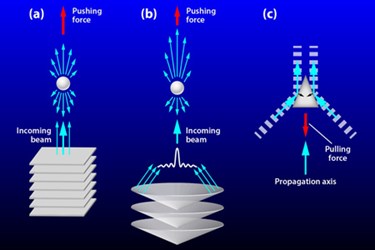Ultrasound Tractor Beam Could Improve Drug Delivery
By Joel Lindsey

Researchers at Scotland’s Dundee University have created and demonstrated what they say is essentially a working tractor beam device, capable of moving objects using ultrasound waves. Such a device, they claim, could prove beneficial in developing new medical applications for ultrasound, including more effectively delivering drug treatments.
“This is the first time anyone has demonstrated a working acoustic tractor beam and the first time such a beam has been used to move anything bigger than microscopic targets,” Christine Demore, a scientist from the university’s Institute for Medical Science and Technology, said in an article published recently by BBC News. “We were able to show that you could exert sufficient force on an object around one centimeter in size to hold or move it, by directing twin beams of energy from the ultrasound array towards the back of the object.”
According to an article published by Mail Online, the device consists of a square array of approximately a thousand ultrasound emitters. Placed at the bottom of a water-filled chamber, the array creates a low-pressure field in front of a hollow triangular target object. Sound waves are simultaneously ricocheted off the rear of the object, causing it to move toward the array.
In early experiments, Demore and the rest of the research team were also able to move objects out of the way of the array's path, as well as cause objects to rotate, Mail Online reported.
Details about the device and results from initial tests have been published recently in the journal APS Physics.
“The concept has been there for a long time,” said Demore. “It took a couple of years to find the right pieces and get them together, with lots of other research going on.”
Researchers involved with the project say that a tractor beam device like the one they’ve developed could revolutionize the field of ultrasound, while also providing innovative ways of delivering drug therapy. Mail Online reports that the device could potentially be used in cancer treatment, providing an effective way to precisely guide drug capsules to specific parts of the body, where they could then release their contents.
“It’s all about understanding how to shape the beam in order to target what we want to,” said Demore. “Our research could lead to big advances in the application of ultrasound-based techniques.”
Image credit: APS/Alan Stonebraker
